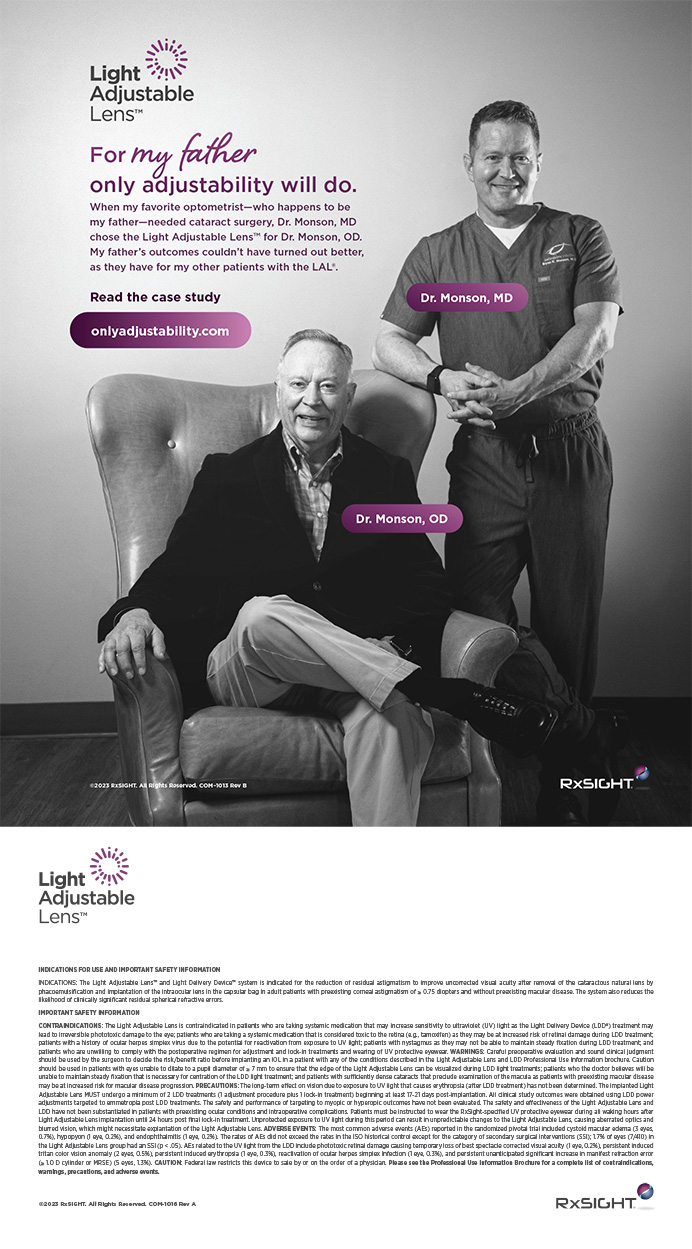Why did you decide to become an ophthalmologist and to subspecialize in cataract and refractive surgery?
When I was a child, I was excited by all the gadgets and technology my ophthalmologist used to diagnose my myopia. The examination helped me see the leaves on a tree, an experience that was, to say the least, eye opening. At that time, I thought, "Wouldn't it be nice if I could just take a drop or have an operation that would help me see without glasses?" These thoughts stuck with me throughout my life. When I think of how much more of the world I could have seen without glasses, I wish I could have undergone LASIK when I was in second grade. I could have played baseball and football without glasses; gone swimming, scuba diving, boating, and skiing; and enjoyed other activities that are limited by poor vision. My dream came true in 1999 with LASIK. I finally was freed from glasses. I am sure if my childhood ophthalmologist could see me now, he would be very excited.
How do you envision the role of technology in ophthalmology?
I was further drawn to ophthalmology while I was in medical school, in part because the profession offered opportunities for innovation. My interest in technology, and how it advances the field, is one of the main reasons I am involved in ophthalmic research and education. I believe that innovation in both areas drives progress in ophthalmology.
Clinical researchers should understand that new technologies will not always fulfill their initial promise. Devices and techniques may fall short or, if we are fortunate, exceed our expectations. Unsuccessful technologies are still valuable, because they may stimulate someone to develop a product that works better.
Some new ideas improve patients' outcomes, some streamline patient flow, and others increase safety. These benefits are true for devices, medications, and new methods of educating patients or doctors. Some technologies have a wide application, and some have a limited application for unique uses. Examples of the latter are the two handheld instruments I developed with Rhein Medical to lift and stabilize the flap while I remove ingrown epithelial cells from the eyes of LASIK patients. I encourage anyone who has an idea that can improve eye care to follow it through to completion, no matter how unique the application, because the result will be worthwhile even if it only helps one patient.
Could you provide an example of how a particular technology has influenced your approach to refractive surgery?
Thanks to my relatively early involvement with phakic IOLs (I participated in clinical trials of the Verisyse and Visian implants) these lenses are now an important part of my practice. I frequently implant phakic IOLs in eyes that previously would have undergone LASIK for high refractive errors.
As an educator, what qualities do you try to instill in your students?
A personally rewarding aspect of my practice has been overseeing the training of residents and fellows both at the University of Minnesota and at Minnesota Eye Consultants. Probably the most important thing I try to teach my students is that they should strive to learn throughout their lives. I tell them that much of what they learn today—maybe all of it—will be supplanted over the course of their careers. I therefore try to provide them with a basic skill set that they can build on as they encounter new situations and work with different colleagues.
What is your most memorable international experience?
I have traveled extensively to international events that range from operating in the eye camps of India to attending meetings in the Swiss Alps. I normally attend these events alone or with my wife, but in 2007, I was invited to a meeting in Chile and decided to bring my wife and daughters with me. The doctors from the Fundaci—n Oftalmol—gica Los Andes, who organized the meeting, provided such a fantastic experience that my children came home with a new understanding of how we all benefit from interactions with different cultures.
My family's trip to Chile gave me the chance to watch my children interact with people from all over the world and reminded me how easily we are influenced by new experiences when we are young. Traveling to Chile motivated my daughters to become involved in the local efforts of Operation EyeSight. The Minnesota Eye Foundation partners with Operation EyeSight to perform free surgery for 1 day twice a year.


